
Common name:Boston Ivy
Botanical name:Parthenocissus tricuspidata
This semi-evergreen vine has dark green leaves that are usually lobed and divided into 3 leaflets. It clings tightly to any surface; it looks great on brick walls. In fall, leaves turn orange or red. Flowers are inconspicuous. During fall, small blue black berries appear to the delight of birds. This vine can grow 50'-60' long but it really depends on what it is growing on. This vine is aggressive.
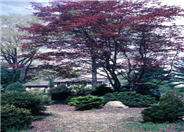
Common name:Red Japanese Maple
Botanical name:Acer palmatum 'Atropurpureum'
This Japanese Maple grows as a small, deciduous tree complete with palmate leaves that turn red and endure for the entire season.
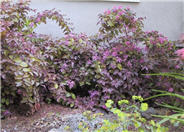
Common name:Red Fringe Flower cultivar
Botanical name:Loropetalum chinense v. rubrum
Red Fringe Flower is a shrub that grows 6'-12' tall and wide. It has arching branches with light green and reddish leaves. Pink flowers bloom intermittently throughout the year. This attractive shrub prefers afternoon shade and shelter from hot, drying winds. It needs a moderate amount of watering.
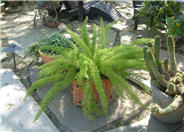
Common name:Myer's Asparagus
Botanical name:Asparagus densiflorus 'Myers'
An evergreen groundcover, the 'Myers' also makes an excellent hanging basket plant when larger in size. Its formal looking fronds have an even, spiral arrangement of leaflets. It is damaged by severe frosts, and looks best with at least occasional watering. -Monterey Bay Nursery
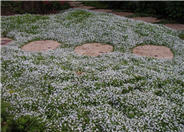
Common name:Blue Star Creeper
Botanical name:Pratia pedunculata
Laurentia fluviatilis has bright green, nearly stemless, 1/4" leaves. In late spring and summer, these form a backdrop for equally tiny, star-shaped pale blue flowers.
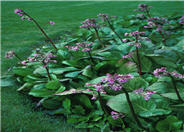
Common name:Heartleaf Bergenia, Winter Bergenia
Botanical name:Bergenia cordifolia
This evergreen perennial has round, heart-shaped, glossy leaves that possess waxy-toothed edges. Its growth is clustered, and flowers that bloom in the spriong are in shades of lilac or rose, held on stems above the leaves.
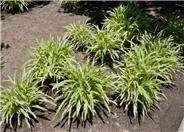
Common name:Dwarf Blue Lily of the Nile
Botanical name:Agapanthus 'Tinkerbell'
This miniature variety of Agapanthus has light blue flowers growing 12"-18" tall. This dwarf hybrid Agapanthus is both smaller in size and has much thinner leaves than its crossed species parents. Foliage exhibits white marginal variegation.
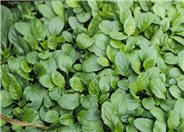
Common name:Ajuga, Bugle Flower, Carpet Bugle
Botanical name:Ajuga reptans
This colorful groundcover will grow in shade or sun with slightly moist soil. It is an evergreen with purplish rosettes that spread quickly on upright, slightly hairy stems. Blue bloom spikes cover these plants in April and May, and are 6-8" when blooming. This versatile groundcover can also be used in shady wildflower beds. -Holland Wildflower Farm
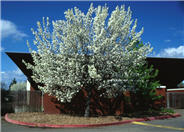
Common name:Evergreen or Flowering Pear
Botanical name:Pyrus kawakamii
This tree grows quickly to about 20' tall and wide. It is has evergreen, glossy, oval, and pointed leaves. White, fragrant, spectacular flowers bloom in spring. Leaves may fall in winter if very cold. It prefers full sun and regular watering, more in hot summer months. Prune in winter. This tree looks great if espaliered. Fruit is inedible.
The natural world works in cycles. Everything is changing form and moving from place to place in an endless energy exchange system. The leaves and twigs that fall to the ground, not to mention other life forms that might die, decompose and combine with water, air and minerals of the soil to create a medium for future plants.
Click in the green box for more information
Designer: Jeff Gamboni Landscape Archite
Photographer: GardenSoft
Practice grass-cycling by leaving short grass clippings on lawns after mowing, so that nutrients and organic matter are returned to the soil.
Remove irrigation water and fertilizer from areas where you don't want weeds to grow.